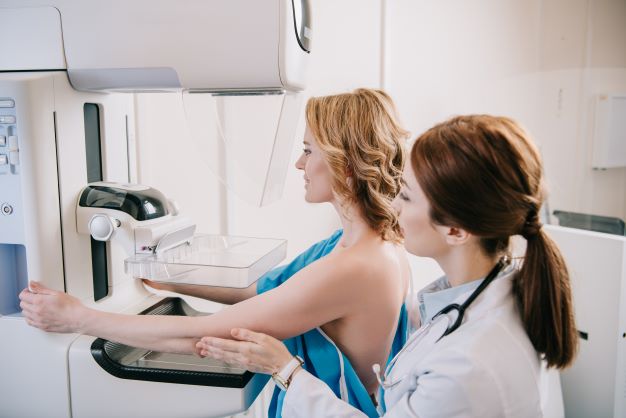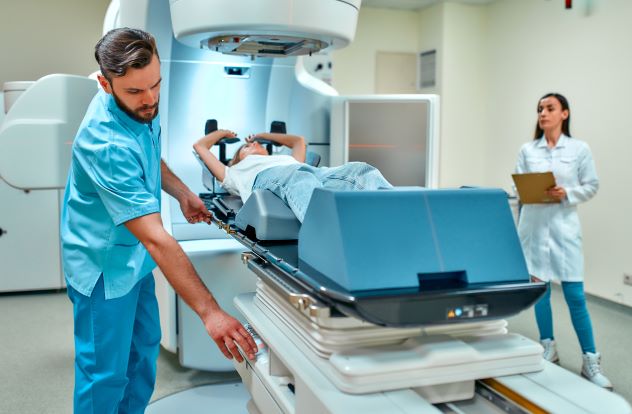It is estimated that 1 in 8 women in the United States will develop invasive breast cancer within their lifetimes. It is an incredibly devastating disease that affects thousands of people a year. This year alone, 281,550 women in the United States will be diagnosed.
Screening efforts and treatment therapies involving molecular imaging and radiation therapy are key to helping detect and successfully treat breast cancer.
Breast Cancer Statistics
- Breast cancer is the most diagnosed cancer in women.
- Breast cancer in women has the highest rate of death compared with any other cancer, besides lung cancer.
- It is more commonly diagnosed in black women under the age of 45 than white women.
- Minority women are 72% more likely than white women to be diagnosed with breast cancer before age 50 and are 127% more likely to die of breast cancer before age 50.
- Men have a 1 in 833 chance of getting breast cancer.
- In 2021, the World Health Organization reported that breast cancer accounted for 12% of all new, worldwide cancer cases.
Breast Cancer Risk Factors
Age and being born female are the biggest risk factors for breast cancer. Women that have direct relatives with a history of breast or cervical cancers such as mothers, sisters, and grandmothers have a higher risk of developing breast cancer in their lifetimes.
There are several known gene mutations that can be inherited from either parent which grant a higher lifetime risk of developing breast cancer as well.
When functioning correctly, these genes, called Breast Cancer Gene 1 (BRCA1) and Breast Cancer Gene 2 (BRCA2), produce proteins that help repair DNA. These tumor suppressor proteins actually help protect from certain cancers by slowing abnormal cell growth and forcing certain damaged cells to stop working entirely.
However, when present, the BRCA gene mutation can prohibit these proteins from working and building correctly, resulting in cancerous tumors.
By age 80, 55%-72% of women with an inherited BRCA1 mutation and 45%-69% with an inherited BRCA2 mutation will develop breast cancer. People with a BRCA variant also tend to develop breast cancer at a much younger age than those without.
There are also higher instances of BRCA1 and BRCA2 gene mutations in certain racial and ethnic groups. For instance, 2% of Ashkenazi Jewish people carry one of the variants. A study in 2009 determined that black and Latin American women were more likely to have BRCA1 mutations.
Signs & Symptoms
The most common symptoms of breast cancer include a lump or mass in the breast, but physical changes in the appearance of the breast are also reported. This includes skin redness or swelling, bloody or abnormal discharge, thickening of the skin, or scaliness.
Breast cancer can develop without presenting any physical symptoms, however, which is why regular screening and breast exams are so important for prevention.
Screening Recommendations
Regular breast cancer screenings can help discover breast cancer in its early stages before it has spread to other parts of the body, therefore, limiting treatment options and increasing mortality rates. Mortality rates can be reduced by 40% with regular screenings.
Mammography
Mammography is a low-dose x-ray procedure used to detect breast cancer in its early stages, often before a patient has experienced any symptoms like lumps or skin alterations.
This type of x-ray exam exposes the patient to low doses of ionizing radiation to produce an image of breast tissue or the inside of the breast.

During a mammography procedure, the breast is flattened between two plates on the x-ray unit for several seconds while an x-ray beam is carefully aimed at the area of concern by the radiologist or technologist performing the procedure. It is standard during a normal screening for two views of each breast to be taken. The mammograms are then reviewed by a radiologist, who looks for early signs of cancer or other abnormalities.
Mammograms can also be used if a patient has experienced symptoms of breast cancer and to screen patients who have been previously treated for breast cancer. This diagnostic mammogram includes additional views of the breast not normally taken during a screening.
Radiation received from regular mammograms is cumulative, however, it does not significantly increase breast cancer risk. In the case of screening for cancer, it is more beneficial in the long run to receive a low radiation dose.
Screening Frequency
Various medical and cancer-related institutions have different guidelines on when it is appropriate or necessary to schedule a mammogram.
The American Cancer Society recommends patients with an average risk of breast cancer between the ages of 45-54 get annual mammograms. Patients aged 55 and older have the option to get a mammogram every other year.
The American College of Radiology (ACR) and the Society of Breast Imaging (SBI) recommend annual mammograms begin at age 40 and continue past age 74.
Molecular Imaging & Breast Cancer
Molecular Imaging is a medical imaging procedure used to help locate breast cancer tumors and determine if cancer has spread to other parts of the body. It is a vital part of the diagnosis and treatment process because it measures biological and chemical processes within the body, compared with regular x-rays which focus on static anatomical images.
Molecular imaging helps physicians determine the appropriate treatment therapies, study the patient’s response to drugs, and closely monitor changes in cellular activity. It is also useful for identifying whether the prescribed therapies are effective and monitoring for reoccurrences.
There are a variety of medical imaging procedures that help visualize chemical processes in the body such as blood flow, oxygen use, or metabolism. Many procedures require an imaging agent such as a radiotracer—a compound containing a small amount of radioactive material—being introduced into the body usually via injection into the bloodstream.
This radiotracer is designed to accumulate in the body in different organs which are then picked up by the imaging device. It can also attach to different cells or groups of cells and paint a clear picture about precisely where abnormal amounts of metabolic activity are occurring.
PET/PET-CT
Positron Emission Tomography (PET) scans alongside Computer Tomography (CT) are one of the most common molecular imaging technologies used for breast cancer. The combination of these two imaging modalities helps physicians determine the exact location of the tumor, what stage the cancer is at, if it has spread, and what type of treatment will be best moving forward.

In this procedure, a radiotracer that naturally emits positrons as it decays is injected into the bloodstream. These positrons react with electrons in the body and produce energy in the form of photons. These photons are detected by the PET scanner, producing 3D images which show how the radiotracer is being distributed.
On a PET scan, the areas where the radiotracer has accumulated appear brighter and more intense than in the surrounding tissue. This is because cancer cells, when active, absorb more glucose. The higher instance of this metabolic activity is made clear thanks to these “hot spots” on the PET scan.
The PET scan is combined with the CT scan to produce a detailed image of both the patient’s anatomy and the metabolic activity present.
Surgical Treatment Options
In addition to chemotherapy, there are several other treatment options for breast cancer that typically precede radiation therapy.
Lumpectomy
A lumpectomy, also known as a partial mastectomy, re-excision, or biopsy, is a breast-conserving surgery that involves removing part of the breast tissue. The surgery removes the lump or tumor plus a small amount of the healthy tissue that surrounds it.
Mastectomy
A mastectomy is a surgical procedure that removes the entire breast. There are different kinds of mastectomies with varying degrees of severity. The type of mastectomy a patient receives will depend on the stage the cancer is at and if it has spread to the lymph nodes or other areas of the body.
Radiation Therapy & Breast Cancer
Radiation therapy delivers ionizing radiation particles to specific areas of the body to destroy cancer cells, either as a standalone treatment or in conjunction with other treatment options like surgery. Brachytherapy and External Beam Radiation Therapy are the two most common treatment types.
Brachytherapy
Brachytherapy is a procedure that involves placing small, sealed radioactive material sources inside the body, either directly inside or next to a tumor. Also known as internal beam radiation, this procedure is used to treat cancer by allowing doctors to deliver higher doses of radiation via a needle or catheter to specific areas of the body.
Compared to other types of radiation treatments, brachytherapy is best for cancers that have not metastasized. It is considered as effective as—and sometimes used in conjunction with—external beam therapy. Due to the nature of brachytherapy procedures, there is a smaller chance of radiation exposure to surrounding healthy tissue and organs than with external radiation as it targets the tumor directly.
Because healthy tissue and organs surrounding the tumor are not as affected by the radiation treatment, most people experience few or less serious side effects than occur with external beam therapy. In addition to tenderness, bleeding, or swelling at the treatment area, the side effects a patient could experience depend largely on the type of cancer and therapy being performed. Fatigue is common.
External Beam Radiation
According to the American Cancer Society, external beam radiation is the most common type of radiation therapy used to treat breast cancer. It can be used in both early-stage breast cancer as well as for advanced stages that cannot be removed with surgery.
EBRT normally occurs 3 to 6 weeks after a patient has undergone surgery and/or completed chemotherapy. Small doses of ionizing radiation are delivered to cancer to destroy the cancerous cells. This process is normally a painless outpatient procedure that lasts up to 5 days a week for anywhere from 2 to 9 weeks.

During EBRT, the patient is usually positioned on their back with their ipsilateral arm placed above their head and their shoulder rotated outward. Then, radiation is precisely applied to the area according to the radiation treatment plan.
Throughout the process, a radiation oncologist monitors a patient’s response to the treatment and may alter the prescribed radiation dose or the number of treatments accordingly.
One 2021 study suggests that a lumpectomy plus radiation therapy offers better survival rates than a standalone mastectomy for early-stage breast cancer. Other studies have discovered that the risk of recurrence in a patient who undergoes radiation therapy is between 5% to 10%, while patients who do not receive radiation therapy have a 20% to 40% recurrence rate.
The Radiation Therapy Team
Each patient who undergoes radiation therapy has a dedicated team of radiation professionals on their side who determine exactly how they will be treated. Throughout the treatment process, they also determine if any changes to the radiation treatment plan need to be adjusted.
A radiation oncologist is a specialist in treating cancer with radiation. Their job is to determine which therapy is the best fit for the patient based on their medical history and physical health.
A medical physicist and dosimetrist will also be a part of this team. They work together with the physician to create the treatment plan.
Radiation therapists and technologists are the individuals who physically administer the radiation therapy treatments and operate the equipment. They are the people patients will interact with the most during their treatment.
The Takeaway
There are a variety of available breast cancer treatment therapies including radiation therapy and surgery. Radiation therapies administered in conjunction with chemotherapy and surgical treatment options have a much lower recurrence rate than standalone treatments.
Proper screening and regular exams are the best way to detect breast cancer when it is in its earliest and most treatable stages. If a patient is 40 or older, it is in their best interest to begin scheduling annual mammograms.
In honor of Breast Cancer Awareness month, check out the following organizations providing patient support services and making great strides in research and awareness:


